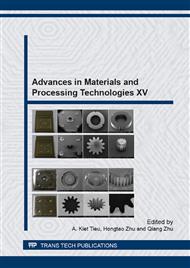p.616
p.626
p.632
p.640
p.646
p.653
p.661
p.670
p.678
Circular Cup Drawing of Magnesium Alloy Sheet under Cold Condition Using Rubber Tool and Improvement of Surface Appearance
Abstract:
In order to accomplish the circular cup drawing of the sheet material whose ductility is extremely poor under the cold forming condition, the Maslennikov's technique was applied. A deformable rubber ring was used instead of the hard punch. Test material was magnesium alloy AZ31-O sheet. Small die profile radius was applied, which was twice or 4 times of the sheet thickness. A semisolid lubricant was used for the lubrication of the blank - die interface, on the other hand, the rubber - blank interface was degreased to increase friction. The limiting drawing ratio of 1.31 was attained. A peculiar fracture mode arises, where the material suddenly fractured with crack evolution emanating from the flange periphery. The fracture strain is found approximately equal to the work hardening exponent n-value in plastic property. Another kind of crack arose in the circumferential direction of the cup during unbending process with smaller die profile radius. To decrease the scratched lines of the cup surface caused by very high sliding contact pressure to the die, high-speed drawing was tested using a drop-weight. The surface was improved, because the material - tool contact was successfully prevented by the hydrodynamic lubrication film.
Info:
Periodical:
Pages:
646-652
Citation:
Online since:
November 2013
Authors:
Keywords:
Price:
Сopyright:
© 2014 Trans Tech Publications Ltd. All Rights Reserved
Share:
Citation:


